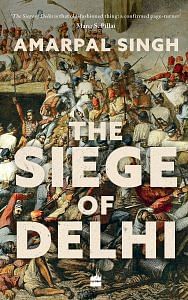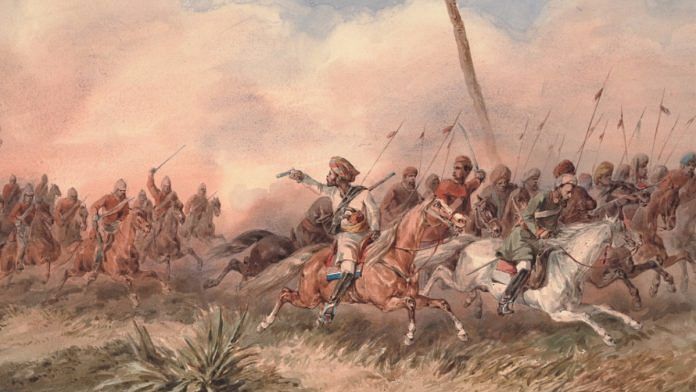In 1803, the Company considered it expedient to retain the Emperor as a puppet – for a time at least – rather than abruptly terminating the dynasty. There seemed to be profit in such a move. The holding of the ‘Great Mogul’ as a pensioner under its protection gave significance and prestige to the Company. As well as grandeur, his presence added legitimacy to their status as the new paramount power in India. Lord Wellesley, Governor-General at the time, certainly seemed to think retaining the Emperor in the Company’s grasp would increase the standing of the British Government. That the Emperor was aging and blind must have also elicited some sympathy among Lord Lake and his cortege at the Durbar. Sir John Kaye, the great chronicler of the mutiny, would write to this effect:
“It was solace to us in the ‘great game’ to know that we ‘held the King’ but it was a puzzle to us how to play the card. It was, indeed, a great political paradox, which Lord Wellesley’s Government was called upon to institute and he did the best that could be done in the circumstances in which he was placed to reconcile not only the House of Timour but the people who still clung reverentially to the great Mahomedan dynasty to the state of things which had arisen out of those circumstances.”
With these arrangements it became clear to all that the imperial family were under the protection of the British Government of India, as made clear in a dispatch from the Governor-General to the Secret Committee on 13 July 1804:
“The deliverance of the Emperor Shah Alam from the control of the French power established in the North-West quarter of Hindustan, by which the Government of France has been deprived of a powerful instrument in the eventual prosecution of its hostile designs against the British Government in India, and the British Government has obtained a favourable opportunity of conciliating the confidence and securing the applause of surrounding states by providing a safe and tranquil asylum for the declining age of that venerable and unfortunate monarch, and a suitable maintenance for his numerous and distressed family.”
Also read: After 1857 rebellion, Delhi properties of ‘disloyal’ Indians were confiscated
It was under these circumstances that Mirza Abu Zafar’s grandfather was kept as nominal ruler of Delhi. By late 1806, his father had succeeded to the throne as Emperor Akbar Shah II. Akbar Shah preferred another prince, Mirza Salim, as his successor. The mother of this prince, one of the many queens of the Emperor, had managed to persuade the Emperor to make her son, who was the third oldest of the princes, his heir apparent.
Mirza Salim was a tactless man who hated the new British ascendancy at Delhi. Rather than masking his true feelings till he gained the throne, Mirza Salim openly mocked Charles Seton, the British Resident in Delhi. One day, in 1812, in a reckless state of mind, he took a potshot at the Resident with his gun. He missed, but the man’s hat was knocked off. Such audacity saw Mirza Salim exiled to Allahabad by the British authorities and wrecked his chances of gaining the throne. Although he was eventually allowed to return to Delhi, he was soon exiled to Allahabad once more for his attempts to poison his older brother. He died at the age of only thirty-one in 1821 from a debauched life defined by a strong preference for cherry brandy.
Akbar Shah now attempted to bestow the succession on another prince, Mirza Nali, but failed to obtain the consent of the British authorities. Mirza Abu Zafar’s elevation to the throne, in reality to the role of roi fainéant, therefore owed much to providence. He eventually succeeded to the throne on 28 September 1837 at the advanced age of sixty-one, having received the Government of India’s imprimatur. His full royal title would now be Mirza Abu Zafar Sirajuddin Mohammad Bahadur Shah Ghazi, or Bahadur Shah II. Bahadur Shah translates to ‘Brave King’ in English. Ghazi is the term for a Muslim warrior dedicated to fighting non-Muslims. These epithets would prove unsuited to the new Emperor, a gentle man and a lover of the arts. He himself preferred to be known simply by his nom de plume, Zafar, meaning victory, although time would tell whether this moniker fit any better.
A royal salute was fired at both Delhi and Agra on Zafar’s accession. Agra was the capital of the North-West Province, the British administrative region which also included Delhi. Zafar happened to be a contemporary of Queen Victoria, who had ascended the throne just four months earlier. The comparison ended there, however. While the young Victoria was leading the British monarchy to its zenith, the ageing Zafar would be holding the last watch.
What is known of Zafar’s childhood is painfully limited. However, in his youth, during his grandfather’s reign, he must have experienced the last faint residues of the prestige and glories of past emperors. Equally, he had seen enough during his during his life to fully understand the full litany of setbacks that had marred the reigns of his father and grandfather, leading to the complete loss of power. Lieut. Ommaney, who was in charge of Zafar as Emperor and who would escort him to his exile in Burma after the mutiny, describes a man that from his looks and personality must have caught the eye when he was in the vigour of youth:
“The ex-king was about eighty-five years old, and must have been a striking man in his prime; his face was of an aristocratic type, with marked features, especially in the nose. He must have been a powerful man too, as the muscles of his arms hung long and flabby in his old age. He had a pleasant expression, and a sense of humour. I should say he was too old to have initiated or taken any active part in the horrors of these days, and was the tool of the bolder and more truculent spirits, male and female, about him.”
Few images of Zafar survive. One potential photographer had arrived as early as 1850. In January of that year, Helen Douglas Mackenzie visited the monarch. Zafar had been smoking his hookah, one of his pastimes, when she entered his apartments. She described him as ‘slender and feeble-looking, but with a simple kindly face, though he took no notice of me when I came in, which I suppose is etiquette’. He was lying on his bed with a woman rubbing his feet. Mrs Mackenzie had come armed with a camera, but it proved difficult to take pictures in the darkness of the room and the balcony was no better. The opportunity passed, although Mackenzie would make some drawings of Zafar’s favourite wife, Zeenat Mahal, and her son. The coronation portrait of Zafar, made in 1837 by the Indian painter Ghulam Ali Khan, shows a confident man with an air of purpose, a subtle smile hinting at a general contentment.
Also read: The British loved their meat, but some were fascinated by Hindu-Brahminical vegetarianism
Throughout his reign, from 1837 to 1857, Zafar made the best of his interest in the arts. He seemed most comfortable in his own restricted world, composing verses and presiding over mushae’ra (gatherings of poets). The missionary C. F. Andrews wrote of the role poetry played at this time:
“The people of the city, for their part, seemed to cherish their poet-king, lauding him for his skill in this difficult art. The citizens were known to sing the Urdu and Persian couplets of Zafar’s work in the streets of the city as they went about their work and leisure.”
As well as poetry, Zafar had a liking for miniatures and excelled at calligraphy. Beauty appealed to him, and despite the parlous state of the treasury he found the funds to lay out the gardens at Shahdara, as well as the gardens below the palace walls. He also liked to play cards and chess. He was known to be a devout Muslim, although syncretic in nature and tolerant of the Hindu beliefs of the majority of the population. He allowed the court to partake in celebrations marking Hindu festivals such as Holi, Diwali, Dussehra, Raksha Bandhan and others with genuine spirit. He was seen as weak in character though, being influenced to an inordinate degree by his favourite wife, Zeenat Mahal. Syed Ahmad Khan, the famous Islamic philosopher of the nineteenth century, also hints at the Emperor having developed some level of imbecility in his later years: ‘The Ex-King had a fixed idea that he could transform himself into a fly or gnat, and that he could in this guise convey himself to other countries, and learn what was going on there. Seriously, he firmly believed that he possessed the power of transformation. He was in the habit of asking his courtiers in Durbar if it were not so, and his courtiers were not the men to undeceive him.’
Leaving aside these failings, the name of the King and his authority, though faded, still held a special resonance for the citizens of Delhi and beyond. Few of the population of Delhi thought that Zafar had any hope of reanimating the corpse of Mughal rule, true, but that didn’t matter at this late stage. Zafar was well respected and loved despite his shortcomings, as C. F. Andrews testified: ‘One of the survivors [of the British siege of the city], who had actually seen him in his Court, told me that he was dearly loved by Hindus and Musalmans alike for his “good manners.” His very foibles and incompetence as a monarch were a part of his attraction for the multitude. He was very peaceful and unwarlike. His subjects would smile at his simplicity. They knew well how ineffective he was, but they loved him all the same.’ When the royal cortege used to travel through the city, the locals would respectfully dismount their horses and everyone would salute as he slowly went past on his elephant.
Zafar, for his part, seemed to enjoy this more personal relationship with the people, and the royal processions around the city were memorable. During Hindu and Muslim festivals, Zafar enjoyed watching the crowds milling in front of the palace from a tower in the fort; the crowds, spotting him, would make their obeisance. On these occasions a public recitation of his poetry would be addressed to the cheering masses. The princes, meanwhile, would ride their richly dressed horses around the streets of the city to soak up some reflected glory. Perhaps the knowledge that Zafar was the last of his line invoked sympathy and affection, allowing his ineffectiveness to be forgiven; certainly, by the time of his reign the British Government of India had made it clear that the pretence of a Timurid dynasty and throne would not continue beyond Zafar’s death.
 Excerpted from The Siege of Delhi by Amarpal Singh. Published by HarperCollins Publishers, 2021.
Excerpted from The Siege of Delhi by Amarpal Singh. Published by HarperCollins Publishers, 2021.






